Punjab State Board PSEB 11th Class Maths Book Solutions Chapter 8 Binomial Theorem Ex 8.2 Textbook Exercise Questions and Answers.
PSEB Solutions for Class 11 Maths Chapter 8 Binomial Theorem Ex 8.2
Question 1.
Find the coefficient of x5 in (x + 3)8
Answer.
It is known that (r + 1)th term, (Tr + 1), in the binomial expansion of (a + b)n is given by Tr + 1 = \({ }^{n} C_{r}\) an – r br
Assuming that x5 occurs in the (r + 1)th term of the expansion (x + 3)8, we obtain
Tr + 1 = \({ }^{8} C_{r}\) (x)8 – r (3)r
Comparing the indices of x in x5 and in Tr + 1, we obtain r = 3.
Thus, the coefficient of x5 is \({ }^{8} C_{3}\) (3)3
= \(\frac{8 !}{3 ! 5 !} \times 3^{3}\)
= \(\frac{8 \cdot 7 \cdot 6 \cdot 5 !}{3 \cdot 2.5 !} \cdot 3^{3}\) = 1512.
![]()
Question 2.
Find the coefficient of a5 b7 in (a – 2b)12.
Answer.
It is known that (r + 1)th term, (Tr + 1), in the binomial expansion of (a + b)n is given by Tr + 1 = \(\) an – r br
Assuming that a5b7 occurs in the (r + 1)th term of the expansion (a – 2b)12,we obtain
Tr + 1 = \({ }^{12} C_{r}\) (a)12 – r (- 2b)r
= \({ }^{12} C_{r}\) (- 2)r (a)12 – r (b)r
Comparing the indices of a and b in a5b7 and in Tr + 1, we obtain r = 7
Thus, the coefficient of a5b7 is
12C7 (- 2)7 = \(\frac{12 !}{7 ! 5 !} \cdot 2^{7}\)
= \(-\frac{12.11 .10 .9 .8 .7 !}{5.4 .3 .2 .7 !} \cdot 2^{7}\)
= – (792) (128)
= – 101376
Question 3.
Write the general term ¡n the expansion of (x2 – y)6.
Answer.
General term in the expansion of (a + b)n is given by
Tr + 1 = \({ }^{n} C_{r}\) an – r br
Tr + 1 = \({ }^{6} C_{r}\) (x2)6 – r (y)r
= \({ }^{6} C_{r}\) x12 – r (- y)r
Question 4.
Write the general term in the expansion of (x2 – 2y)12, x ≠ 0.
Answer.
It is known that the general term Tr + 1 {which is the (r + 1)th term} in the binomial expansion of (a + b)n is given by Tr + 1 = \({ }^{n} C_{r}\) an – r br
Thus, the general term in the expansion of (x2 – yx)12 is
Tr + 1 = \({ }^{12} C_{r}\) (x2)12 – r (- yx)r
= (- 1)r \({ }^{12} C_{r}\) x24-2r . yr . xr
= (- 1)r \({ }^{12} C_{r}\) x24 – r . yr
![]()
Question 5.
Find the 4th term in the expansion of (x – 2y)12.
Answer.
It is known that (r + 1)th term, (Tr + 1), in the binomial expansion of (a + b)n is given by Tr + 1 = \({ }^{n} C_{r}\) an – r br
Thus, the 4th term in the expansion of (x – 2y)12 is
T4 = T3 + 1
= \({ }^{12} C_{3}[/latex (x)12 – 3 (- 2y)3
= (- 1)3 . [latex]\frac{12 !}{3 ! 9 !}\) . x9 . (2)3 . y3
= – \(\frac{12 \cdot 11 \cdot 10}{3.2}\) . x9 . (2)3 . y3
= – 1760 x9 . x9 . y3
Question 6.
Find the 13th term in the expansion of (9x – \(\frac{1}{3 \sqrt{x}}\))18, x ≠ 0.
Answer.
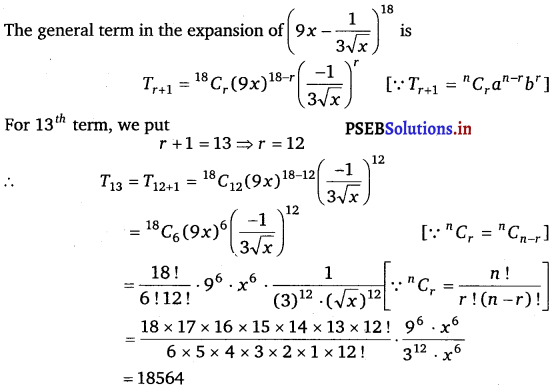
![]()
Question 7.
Find the middle terms in the expansions of \(\left(3-\frac{x^{3}}{6}\right)^{7}\).
Answer.
It is known that in the expansion of (a + b)n, if n is odd, then there are two middle terms, namely \(\left(\frac{n+1}{2}\right)^{t h}\) term and \(\left(\frac{n+1}{2}+1\right)^{t h}\) term.
Therefore, the middle terms in the expansion of \(\left(3-\frac{x^{3}}{6}\right)^{7}\) are \(\left(\frac{7+1}{2}\right)^{t h}\)
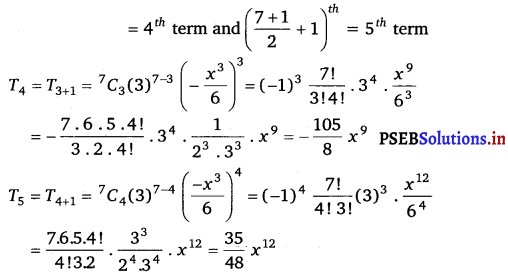
Thus, the middle terms in the expansion of \(\left(3-\frac{x^{3}}{6}\right)^{7}\) are – \(\frac{105}{8}\) x9 and \(\frac{35}{48}\) x12.
Question 8.
Find the middle terms in the expansions of \(\left(\frac{x}{3}+9 y\right)^{10}\).
Answer.
It is known that in the expansion (a + b)n, if n is even, then the middle term is \(\left(\frac{n}{2}+1\right)^{t h}\) term.
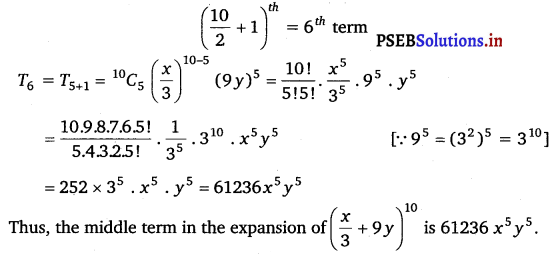
Therefore, the middle term in the expansion of \(\left(\frac{x}{3}+9 y\right)^{10}\) is 61236 x5 y5.
![]()
Question 9.
In the expansion of (1 + a)m + n, prove that coefficients of am and an are equal.
Answer.
It is known that (r + 1)th term, (Tr + 1), in the binomial expansion of (a + b)n is given by
Tr + 1 = \(\) an – r br.
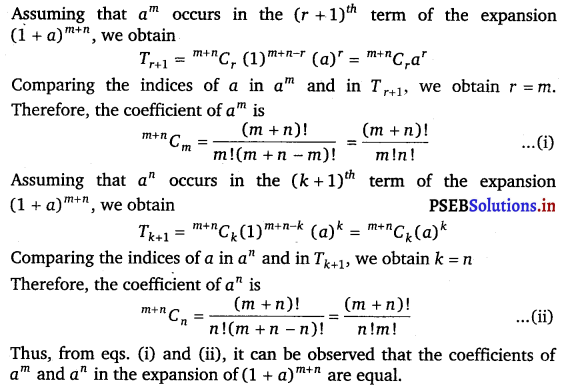
Question 10.
The coefficients of the (r – 1)th, rth and (r + 1)th terms in the expansion of (x + 1)n are in the ratio 1 : 3 : 5. Find n and r.
Answer.
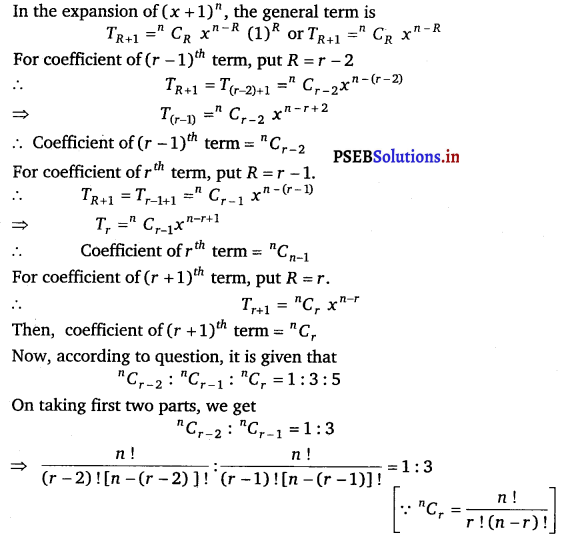
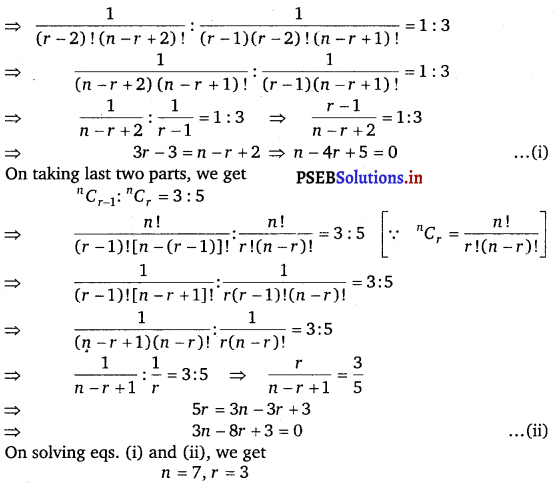
![]()
Question 11.
Prove that the coefficient of xn in the expansion of (1 + x)2n is twice the coefficient of xn in the expansion of (1 + x)2n – 1.
Answer.
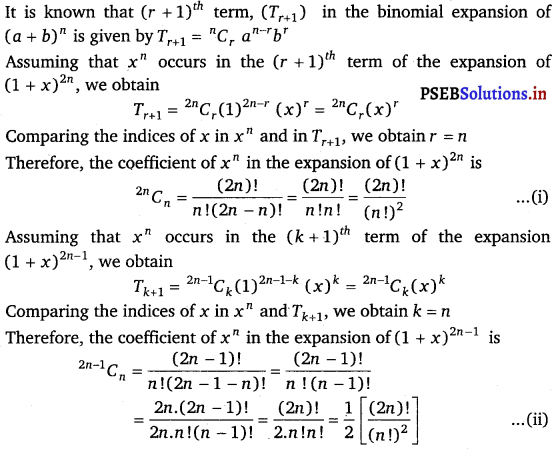
From eqs. (i) and (ii), it is observed that \(\frac{1}{2}{ }^{2 n} C_{n}={ }^{2 n-1} C_{n}\).
\({ }^{2 n} C_{n}=2\left({ }^{2 n-1} C_{n}\right)\)Therefore, the coefficient of xn in the expansion of (1 + x)2n is twice the coefficient of xn in the expansion of (1 + x)2n – 1.
Hence proved.
![]()
Question 12.
Find a positive value of m for which the coefficient of xn in the expansion (1 + x)m is 6.
Answer.
It is known that (r + 1)th term, (Tr + 1), in the binomial expansion of (a + b)n is given by Tr + 1 = \(\) an – rbr.
Assuming that x2 occurs in the (r + 1)th term of the expansion (1 + x)m, we obtain
\(T_{r+1}={ }^{m} C_{r}(1)^{m-r}(x)^{r}={ }^{m} C_{r}(x)^{r}\)
Comparing the indices of x in x2 and in Tr + 1, we obtain r = 2
Therefore, the coefficient of x2 is \({ }^{m} C_{2}\)
It is given that the coefficient of x2 in the expansion (1 + x)m is 6.
\({ }^{m} C_{2}\) = 6
⇒ \(\frac{m !}{2 !(m-2) !}\) = 6
⇒ \(\frac{m(m-1)(m-2) !}{2 \times(m-2) !}\) = 6
⇒ m (m – 1) = 12
⇒ m2 – m – 12 = 0
⇒ m2 – 4m + 3m – 12 = 0
⇒ m(m – 4) + 3(m – 4) = 0
⇒ (m – 4) (m + 3) = 0
⇒ (m – 4) = 0 or (m + 3) = 0
⇒ m = 4 or m = – 3.
Thus, the positive value of m, for which the coefficient of x2 in the expansion (1 + x)m is 6, is 4.
